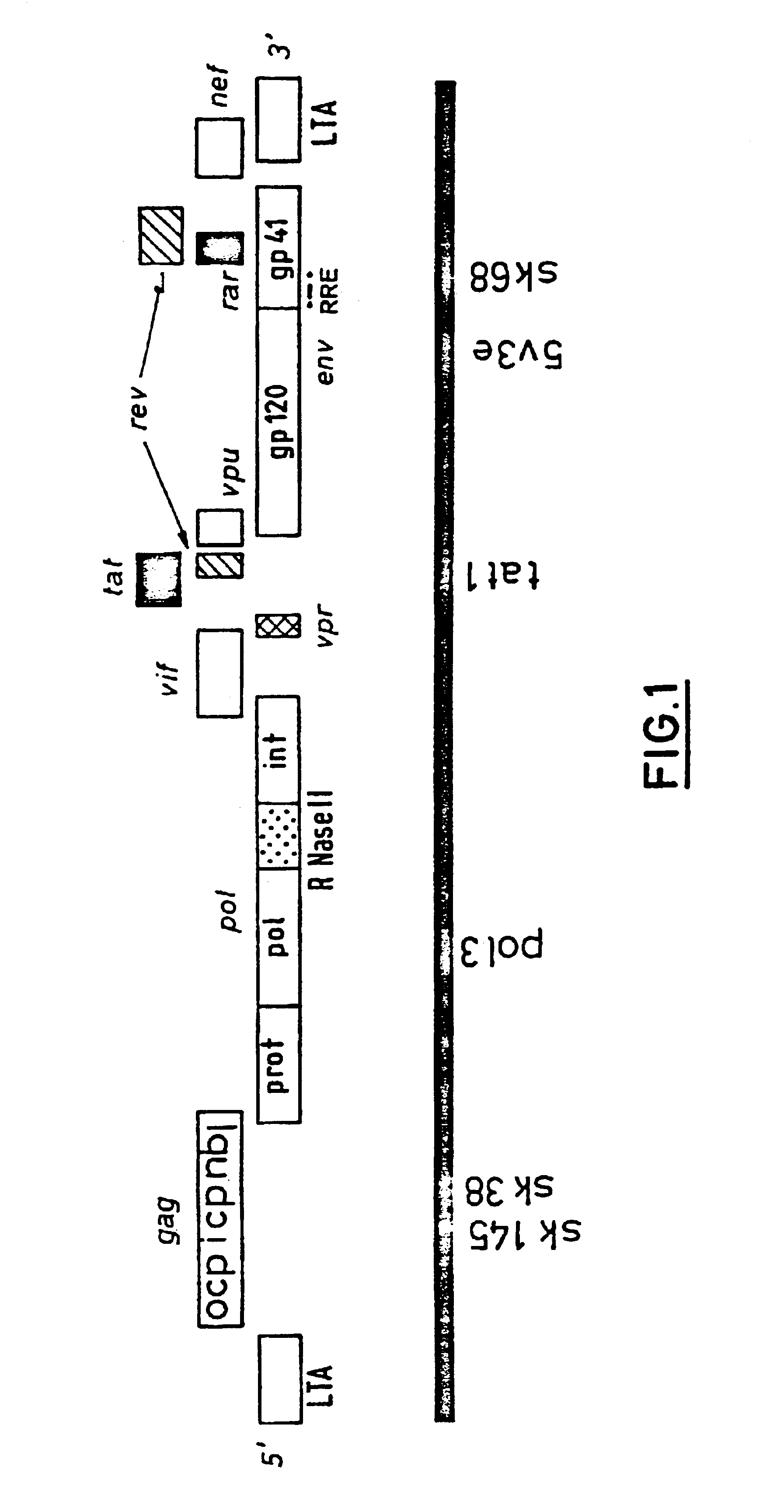Retrovirus from the HIV type O and its use (MVP-2901/94)
a technology of retrovirus and hiv type, applied in the field of retrovirus, can solve the problems of affecting the comparability of different isolates, unable to detect antibodies or only weakly in some sera, and presenting a substantial problem in the genotypic diversity of hiv viruses
- Summary
- Abstract
- Description
- Claims
- Application Information
AI Technical Summary
Benefits of technology
Problems solved by technology
Method used
Image
Examples
example 2
DNA Isolation and Amplification and Structural Characterization of Segments of the Genome of the HIV Isolate MVP-2901 / 94 (Encoding gp 41)
[0059]Genomic DNA was isolated from MVP-2901 / 94-infected blood lymphocytes using standard methods (Current Protocols in Molecular Biology, Wiley Interscience, 1994).
[0060]In order to characterize the regions of the genome of the MVP-2901 / 94 isolate, PCR (polymerase chain reaction) experiments were carried out using primer pairs from the gp 41 coat protein region. The PCR (Saiki et al., Science 239: 487-491, 1988) was carried out with the following modifications:
[0061]For the amplification of HIV-specific DNA regions, 5 μl (200 μg / ml) of genomic DNA from MVP-2901 / 94-infected blood lymphocytes were pipetted into a 100 μl reaction mixture (0.25 mM dNTP, 1 μM for each primer, 10 mM tris / HCl, pH 8.3, 50 mM KCl, 1.5 mM MgCl2, 0.001% gelatin, 2.5 units of Taq polymerase (Perkin Elmer)) and amplified in accordance with the following temperature program: 1....
example 3
Distinguishing the MVP-2901 / 94 Isolate from other HIV Isolates
[0069]The nucleotide sequence which was found, and which is depicted in Table 1, was examined for homologous sequences in the GENEBANK database (Release 83, June 1994) and the EMBL database (Release 38, March 1994), while the protein sequence deduced from it was examined with the SWISSPROT protein database (Release 28, February 1994) using the GCG computer program (Genetic Computer Group, Inc. Wisconsin USA, version 7.1, March 1992). Most of the nucleotide sequences which were known in July 1994 for immunodeficiency viruses of human origin, and for isolates from primates are contained in these databases.
[0070]In the best instance, the nucleotide sequence in Table 1 exhibits an homology of 79.6% with an HIV-1 subtype O isolate. The best homology with another HIV-1 subtype is 59.6%. At best, the DNA in Table 1 is 51.6% homologous with HIV-2 isolates.
[0071]In the best instance, the amino acid sequence in Table 1 exhibits 72....
example 4
Serological Data Relating to MVP-2901 / 94
[0080]In order to evaluate the importance of this virus for serodiagnosis, a serum sample from the patient infected with 2901 was examined in various commercial anti-HIV-1 / 2 screening tests.
[0081]The results of these investigations are presented in Table 4.
[0082]
TABLE 4EnzygnostAbbott Anti-anti-HIV-1 / -HIV-1 / 2, 3rdOrtho / CBC2901 gp 41SampleHIV-2generationAnti-HIV-1 / 2peptide2901 0.70.50.44.2
Values in O.D. / Cut-off Ratio
[0083]It is evident from Table 4 that none of the commercially available test kits detects this sample. If, by contrast, a novel ELISA is employed which uses a peptide (NQQRLNLWGCKGKLICYTSVKWN) which, with the exception of one amino acid (NQQRL instead of NQQLL), corresponds to the 2901 sequence as the solid phase antigen and uses the Enzygnost anti-HIV-1 / 2 reagents as the liquid reagents, the sample is then detected reliably. Commercially available Western blots such as, for example, that from Pasteur, do not detect this MVP2901 / 94...
PUM
| Property | Measurement | Unit |
|---|---|---|
| volume | aaaaa | aaaaa |
| pH | aaaaa | aaaaa |
| pH | aaaaa | aaaaa |
Abstract
Description
Claims
Application Information
 Login to View More
Login to View More - R&D
- Intellectual Property
- Life Sciences
- Materials
- Tech Scout
- Unparalleled Data Quality
- Higher Quality Content
- 60% Fewer Hallucinations
Browse by: Latest US Patents, China's latest patents, Technical Efficacy Thesaurus, Application Domain, Technology Topic, Popular Technical Reports.
© 2025 PatSnap. All rights reserved.Legal|Privacy policy|Modern Slavery Act Transparency Statement|Sitemap|About US| Contact US: help@patsnap.com

